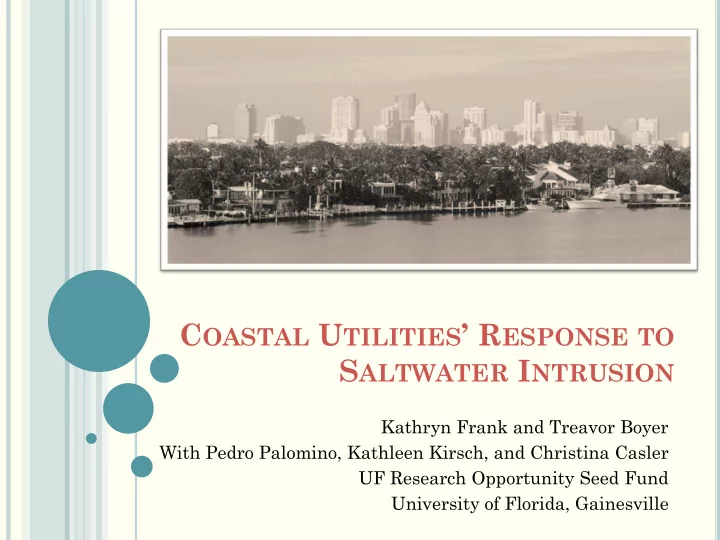

C OASTAL U TILITIES ’ R ESPONSE TO S ALTWATER I NTRUSION Kathryn Frank and Treavor Boyer With Pedro Palomino, Kathleen Kirsch, and Christina Casler UF Research Opportunity Seed Fund University of Florida, Gainesville
S ALTWATER I NTRUSION H EALTH C ONCERN Long-term Coastal Groundwater Stressors Urbanization Agriculture Climate Change Sea Level Rise Public Disinfection Saltwater Water Byproducts Intrusion Supply Disinfection Regulated Salt ions: Process Carcinogenic Bromide Compounds Chlorine
A PPLIED S CIENCE F RAMEWORK : U TILITIES A DAPTATION P LANNING EPA’s Climate Ready Water Utilities Adaptation Strategies Guide Climate Resilience Evaluation and Awareness Tool (CREAT) Florida Water and Climate Alliance UF Water Institute
F LORIDA C OASTAL U TILITIES S URVEY Objective : Understand utility mindset towards saltwater intrusion Water supply, management and planning, Concerns and strategies Method : Online survey (TREEO) Summer 2013, Winter 2013 Applied science adaptive framework
S URVEY R ESULTS
U TILITY R ESPONDENTS 13 analyzed responses 10 counties Populations served Low 1,346 High 156,254 Taylor Flagler Volusia Average 69,713 All 100% groundwater Brevard Pasco Aquifer types Floridan Martin Biscayne Palm Beach Upper Surficial Broward Collier Sand and Gravel Miami-Dade Wellfield distance from coast Average 9 miles
S ALTWATER I NTRUSION – F ACTORS A FFECTING U TILITY Increased Drawdown 8% 17% 25% Decreased 33% Recharge Sea Level Rise 8% 33% 59% 17% Other I ncluded “Well Rotation” and “Canal” In 50 years Now Saltwater intrusion expected to impact utility: Average Year 2076
S ALTWATER I NTRUSION – F EASIBLE AND I MPLEMENTED A DAPTATION S TRATEGIES Practice water conservations Install new wells further inland Improve treatment to address WQ issues Implemented Limit SWI through barriers and aquifer recharge Agree Neutral Facilitate water recycling Disagree Connect with regional water supplies Diversify water supply options 0 2 4 6 8 10 12
C LIMATE C HANGE – I NFORMATION AND P LANNING 85% respondents Frequency discussing believe climate change climate change at utility is occurring 33% familiar with At least quarterly utility adaptation Yearly strategies Never
F ACTORS A FFECTING C LIMATE C HANGE P LANNING Utility constraints More immediate problems prioritized Current state of utility and infrastructure Information constraints Insufficient science and uncertainty Insufficient dialog between scientists and utilities Unfamiliar with planning tools No utilities used EPA’s Strategies Guide or CREAT
C ONCLUSIONS Some utilities are planning for saltwater intrusion and climate change. Need greater understanding of specific impacts and adaptation planning tools Saltwater intrusion is not an imminent concern. Communication between scientists, utilities, and policy makers needs improvement.
N EXT S TEPS IN R ESEARCH Focus on Florida utilities’ Saltwater intrusion monitoring, modeling, adaptation Interest in using adaptation planning tools Water quality concerns; water treatment and disinfection process Utility interviews and case study
Recommend
More recommend